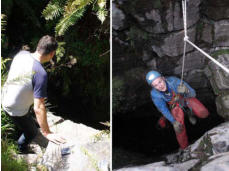


Cave Access










Legal aspects of cave access
Visiting caves on private land is ultimately at the discretion of the landowner. Some landowners have entered into access agreements with groups that administer cave access on their behalf. In other cases there might be de facto unchallenged access and at the opposite extreme cave visitors may not be welcomed at all. Some caves are located on “Access Land” where there is a legal right to “open-air recreation”. This is the right- to-roam used mainly by walkers but applicable to any outdoors activity that is not excluded by Schedule 2 of the Countryside and Rights of Way Act 2000 (CROW). As caving is not excluded, and with strong legal advice, it is the opinion of the British Caving Association and the Cambrian Caving Council that the public has a right to explore caves on CROW Access Land. That view is not supported by Natural Resources Wales (NRW) who claim that caving is not an “open-air recreation”. This difference of opinion concerns the meaning of the words “open-air” in CROW Act and NRW has confirmed that it has nothing to do with discouraging cave visits. Urban Commons are another legal category of land quite separate from CROW. These commons provide the public with a right to take “air and exercise” there under Section 193 of the Law of Property Act 1925 (LPA). Nobody is disputing that caving is a form of “air and exercise” but NRW claims that caves situated on common land are not part of common land so they do not fall within the ambit of the LPA for recreational purposes. This stance is even more tenuous than NRW’s claims about the CROW Act because Section 205 of LPA defines land 3-dimensionally so as to include strata, mines and whatever else might be underneath the land surface. . The walker in the photo on the left and the caver abseiling are both at the top of a cave on Access Land. NRW would say that the walker here is legal because walking is “open-air recreation” while the caver is a trespasser unless he has access permission from the landowner. The person in shorts in the middle photo is standing outside another cave on Access Land and though wearing a caving helmet is exercising the “right to roam” as a walker - but the four people under the cavern roof who are still quite near to daylight are trespassers according to NRW unless they have access permission from the landowner. It would take a High Court case to settle this. Fortunately for cavers, NRW’s narrow interpretations of “open-air” and “land” might become a thing of the past. The Welsh Government has announced reforms to legislation in Wales to allow wider legal usage of the countryside for recreation, for example to allow swimming, cyclists, paragliders and equestrians on Access Land by removing their exclusion from within the CROW Act. There is no such prohibition on going caving so none can be removed. The Cambrian Caving Council hopes to persuade the government to simplify and clarify the legal wording, such as by deleting “open-air” and simply referring to “recreation”, and to define “land” open for recreational access simply as “the land surface and whatever is beneath it or above it” as is done in Scotland. This will be in harmony with the public policy in Wales: enabling more people to enjoy the countryside more easily, to obtain health and wellbeing benefits from being outdoors, encouraging tourism, instilling a sense of national pride, and delivering public goods for all the people of Wales and visitors to this beautiful country.
Cambrian Caving Council









